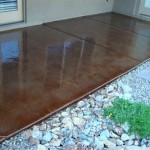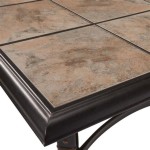How To Make A Concrete Patio Look Nice
A concrete patio, while durable and cost-effective, can often appear utilitarian and lacking in character. Its plain gray surface can be uninspiring, detracting from the overall aesthetics of an outdoor living space. However, with careful planning and execution, a concrete patio can be transformed into an inviting and visually appealing area for relaxation and entertainment. Several approaches can be employed, ranging from surface treatments and enhancements to incorporating decorative elements and strategic landscaping. The goal is to move beyond the basic functionality of the concrete slab and create a cohesive and attractive outdoor environment.
Improving the appearance of a concrete patio often involves addressing its inherent limitations: its color, texture, and perceived coldness. Simple steps such as cleaning and sealing can dramatically enhance its existing features, while more involved projects like staining, painting, or resurfacing can completely alter its look. Integrating the patio with its surrounding landscape and incorporating comfortable furniture and decorative accessories are crucial for creating a welcoming and stylish outdoor space. Considering the patio's usage, the existing architectural style of the house, and the surrounding environment will guide the selection of appropriate design strategies and materials.
Surface Treatments and Enhancements
One of the most immediate and effective ways to enhance a concrete patio is through surface treatments. These can range from basic cleaning and sealing to more elaborate techniques like staining, painting, and resurfacing. The choice of treatment depends on the desired aesthetic, the condition of the existing concrete, and the budget allocated for the project.
Cleaning and Sealing: Before undertaking any decorative enhancements, a thorough cleaning is essential. Pressure washing is often the most effective method for removing dirt, grime, mold, and mildew. For stubborn stains, specialized concrete cleaners can be used. Once the patio is clean and dry, applying a concrete sealer is highly recommended. A sealer protects the concrete from moisture penetration, prevents staining, and enhances its durability. Sealers are available in various finishes, from matte to glossy, allowing for customization of the patio's appearance. Regular cleaning and resealing (typically every 1-3 years) are crucial for maintaining the patio's appearance and longevity.
Staining: Concrete staining offers a way to add color and depth to the patio without completely obscuring the concrete's natural texture. There are two main types of concrete stains: acid-based and water-based. Acid-based stains react chemically with the concrete, creating a permanent, mottled effect. They are known for their durability and resistance to fading. Water-based stains, on the other hand, are less reactive and offer a wider range of colors. They are also more environmentally friendly and easier to apply. When staining, proper surface preparation is crucial. The concrete must be clean, dry, and free of any sealers or coatings. Applying the stain evenly and allowing it to dry completely before sealing is essential for achieving the desired result. Experimenting with different application techniques, such as sponging or layering, can create unique and artistic effects.
Painting: Painting concrete is another option for adding color and pattern to a patio. However, it is essential to use a paint specifically designed for concrete surfaces. Concrete paints, typically acrylic-latex based, are formulated to withstand the wear and tear of outdoor use and adhere properly to the porous surface. Before painting, the concrete must be thoroughly cleaned and primed with a concrete primer. The primer helps the paint adhere better and prevents moisture from penetrating the concrete. Multiple coats of paint may be necessary to achieve the desired color and coverage. Stencils and templates can be used to create decorative patterns or borders. While painting can provide a quick and affordable way to transform a patio, it is important to note that it may not be as durable as staining and may require more frequent reapplication.
Resurfacing: For patios with significant cracks, chips, or other imperfections, resurfacing may be the best option. Concrete resurfacing involves applying a thin layer of cement-based overlay to the existing concrete surface. This overlay can be textured, stamped, or colored to create a variety of looks, including the appearance of brick, stone, or tile. Resurfacing can also correct uneven surfaces and provide a smooth, uniform base for further decorative treatments. This process typically involves preparing the existing concrete surface by cleaning and patching any cracks or holes. A bonding agent is then applied to ensure proper adhesion of the overlay. The overlay is mixed and applied according to the manufacturer's instructions, and the desired texture or pattern is created. Once the overlay has cured, it can be sealed to protect it from moisture and staining. Resurfacing is a more involved and expensive process than staining or painting, but it can provide a dramatic transformation and extend the life of the patio.
Incorporating Decorative Elements
Beyond surface treatments, incorporating decorative elements can significantly enhance the visual appeal of a concrete patio. These elements can add color, texture, and interest, transforming a plain concrete slab into a stylish and inviting outdoor space.
Furniture and Accessories: Selecting the right furniture is crucial for creating a comfortable and visually appealing patio. Consider the size of the patio and the desired style when choosing furniture. Wicker, wrought iron, and teak are popular choices for outdoor furniture due to their durability and weather resistance. Adding comfortable cushions and throw pillows in vibrant colors and patterns can instantly brighten up the space. Outdoor rugs can define seating areas and add warmth and texture to the concrete surface. Consider using rugs made from materials like polypropylene or jute, which are resistant to moisture and fading. Decorative accessories, such as lanterns, candles, and sculptures, can add personality and ambiance to the patio. Choosing accessories that complement the overall style of the outdoor space will create a cohesive and inviting environment.
Planters and Greenery: Incorporating plants and greenery is an essential element of any inviting outdoor space. Potted plants of various sizes and shapes can add color, texture, and visual interest to a concrete patio. Using a variety of plants, including flowers, shrubs, and trees, can create a layered and dynamic landscape. Consider using planters made from materials like terracotta, concrete, or wood to complement the patio's design. Climbing plants, such as ivy or clematis, can be trained to grow along walls or pergolas, adding vertical interest and creating a sense of privacy. A small herb garden can also be a practical and attractive addition to a patio, providing fresh herbs for cooking and adding a fragrant aroma to the space.
Lighting: Outdoor lighting is crucial for creating a welcoming and functional patio after dark. String lights can add a festive and whimsical touch to the space, while lanterns and candles can provide a warm and intimate glow. Path lighting can illuminate walkways and steps, enhancing safety and creating a sense of drama. Spotlights can be used to highlight architectural features or trees. Solar lights are an energy-efficient and easy-to-install option for adding ambient lighting to the patio. When choosing outdoor lighting, it is important to consider the style of the space and the desired level of illumination. Using a combination of different types of lighting can create a layered and dynamic effect.
Water Features: Introducing a water feature, such as a small fountain or a decorative pond, can add a sense of tranquility and serenity to a concrete patio. The sound of running water can be very relaxing and can help to mask unwanted noise. Water features can also attract birds and other wildlife, adding to the natural ambiance of the space. There are many different types of water features to choose from, ranging from small tabletop fountains to large, elaborate ponds. When selecting a water feature, it is important to consider the size of the patio and the desired style. Ensure that the water feature is properly maintained to prevent algae growth and keep the water clean.
Integrating with the Surrounding Environment
A concrete patio should not exist in isolation. Integrating it seamlessly with the surrounding landscape and architectural style of the house is crucial for creating a harmonious and visually appealing outdoor space. This involves considering the patio's location, the existing landscaping, and the overall design aesthetic.
Landscaping: The surrounding landscaping plays a vital role in enhancing the appearance of a concrete patio. Planting trees, shrubs, and flowers around the patio can soften its hard edges and create a more natural and inviting environment. Consider using plants that complement the color and style of the patio and the house. Creating a winding pathway leading to the patio can add a sense of mystery and intrigue. Using different types of ground cover, such as gravel, mulch, or stepping stones, can add texture and visual interest to the landscape. Maintaining the landscaping around the patio is essential for keeping it looking its best. Regularly pruning trees and shrubs, weeding flower beds, and mowing the lawn will help to create a tidy and well-maintained outdoor space.
Defining Boundaries: Clearly defining the boundaries of the patio can help to create a sense of enclosure and privacy. This can be achieved through various means, such as installing a fence, building a low wall, or planting a hedge. A fence or wall can provide privacy and protection from the wind, while a hedge can add a natural and organic touch. Trellises with climbing plants can also be used to create a living wall, providing both privacy and visual interest. Consider the style of the house and the surrounding landscape when choosing a boundary treatment. The boundary should complement the overall design of the outdoor space and provide a sense of cohesion.
Extending Living Spaces: A concrete patio can be designed as an extension of the indoor living space, blurring the lines between the interior and exterior. This can be achieved by using similar materials and colors both indoors and outdoors. For example, using the same flooring material on the patio as in the adjacent room can create a seamless transition. Installing large windows or sliding glass doors can also help to connect the indoor and outdoor spaces. Creating an outdoor kitchen or dining area can further extend the living space and provide a functional and inviting area for entertaining. Consider the flow of traffic between the indoor and outdoor spaces when designing the patio layout. Ensure that there is ample space for movement and that the patio is easily accessible from the house.
By carefully considering these strategies, a concrete patio can be transformed from a utilitarian surface into a beautiful and inviting outdoor living space. The key is to focus on enhancing the surface, incorporating decorative elements, and integrating the patio seamlessly with its surrounding environment. The result will be a patio that is not only functional but also aesthetically pleasing, providing a comfortable and stylish area for relaxation and entertainment.

5 Simple Tweaks For A More Beautiful Concrete Patio

5 Simple Tweaks For A More Beautiful Concrete Patio

Concrete Patio Ideas To Dress Up A Drab Space Bob Vila

How I Made My Patio Look New Again With Olympic Rescue It

Concrete Patio Ideas To Dress Up A Drab Space Bob Vila

9 Great Concrete Patio Ideas For A Makeover Remodelaholic

How To Create Faux Tile Look On Concrete Patio Southern Hospitality

Inexpensive Ways To Cover A Concrete Patio

9 Great Concrete Patio Ideas For A Makeover Remodelaholic

Concrete Patio Ideas To Dress Up A Drab Space Bob Vila








